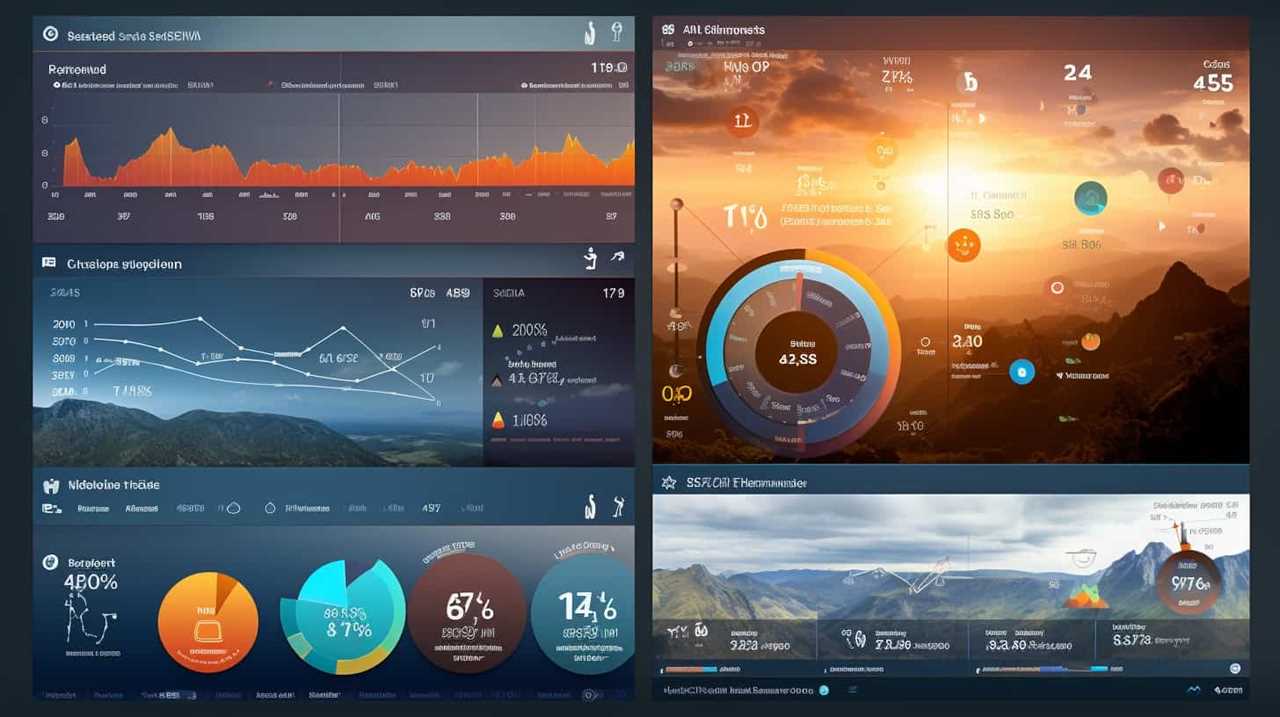We recognize your zeal for mastering the art of crafting impactful SEO content. Look no further! In this article, we will lead you in developing compelling and optimized material that will markedly improve your website’s prominence.
From conducting keyword research to incorporating keywords naturally, we’ve got you covered. Discover the secrets to creating engaging titles and optimizing your content structure for maximum impact.
Don’t miss out on this opportunity to enhance your SEO skills and boost your online presence. Let’s dive in!
Key Takeaways
- Implement effective SEO techniques to enhance website visibility
- Conduct keyword research to optimize SEO text
- Craft engaging and relevant titles to increase content discovery
- Optimize content structure with headings and meta tags for improved SEO
Understanding SEO Text and Its Importance
We will now delve into the significance of understanding SEO text and its importance in driving online visibility.

SEO strategies for improving website rankings and the impact of SEO on online marketing success are crucial to grasp for anyone seeking mastery in this field. Implementing effective SEO strategies is essential in order to enhance the visibility and discoverability of a website on search engine results pages. By optimizing the content with relevant keywords and implementing various on-page and off-page SEO techniques, websites can rank higher in search engine rankings and attract more organic traffic.
This increased visibility can ultimately lead to improved online marketing success, as more users are able to find and engage with the website. Understanding SEO text is the first step towards achieving these goals, and conducting keyword research for SEO text is an integral part of this process.
Conducting Keyword Research for SEO Text
How can we effectively conduct keyword research for SEO text?
Conducting keyword research is an essential step in creating optimized SEO text. To start, we can focus on long tail keywords, which are more specific and targeted phrases that have lower competition. These keywords are valuable because they can attract highly motivated and relevant traffic to our website.

Additionally, conducting competitive keyword analysis can provide valuable insights into the keywords our competitors are targeting and the strategies they’re using. By understanding our competition, we can identify opportunities to differentiate ourselves and target keywords that may have higher search volume and lower competition.
Crafting an Engaging and Relevant Title
Crafting an Engaging and Relevant Title is crucial for optimizing SEO text. The title is the first thing that grabs the reader’s attention and influences their decision to click and read the content. When crafting catchy titles, it is important to utilize power words that evoke emotion and entice the audience to engage with the content. To give you an idea of how power words can impact the effectiveness of a title, here is a table showcasing the difference between a generic title and one that incorporates power words:
| Generic Title | Title with Power Words |
|---|---|
| Tips for Cooking | Master the Art of Cooking |
| Benefits of Exercise | Unlock the Power of Exercise |
| Ways to Save Money | Supercharge Your Savings |
| Beauty Hacks | Transform Your Beauty Routine |
Crafting an engaging and relevant title sets the tone for the rest of the content and increases the chances of it being discovered and clicked on. Now, let’s delve into the next section on optimizing content structure for SEO.
Optimizing Content Structure for SEO
When it comes to optimizing content structure for SEO, there are a few key points to keep in mind.

First, headings play a crucial role in signaling to search engines what your content is about. Including relevant keywords in your headings can help improve your visibility in search results.
Additionally, strategically placing keywords throughout your content, while maintaining a natural flow, can further enhance your SEO efforts.
Lastly, don’t forget the importance of meta tags, as they provide a brief summary of your content and can influence click-through rates.
Headings for SEO
We optimize content structure for SEO by strategically using headings. Headings play a crucial role in improving the user experience and search engine visibility of a webpage.

Here are three reasons why headings are important for SEO:
- Organize Content: Headings help break down the content into logical sections, making it easier for users to navigate and understand the information.
- Highlight Relevance: By incorporating keywords into headings, you can signal to search engines the relevance of your content to specific queries.
- Improve Readability: Well-structured headings make your content more scannable, allowing users to quickly find the information they need.
Optimizing headings involves using relevant keywords, using proper heading tags (H1, H2, etc.), and ensuring consistency throughout the page. By paying attention to headings optimization, you can enhance the overall SEO performance of your content.
Keyword Placement Tips
To optimize the structure of your content for SEO, it’s essential to carefully place keywords throughout your text. Keyword optimization plays a crucial role in improving your website’s visibility and ranking on search engine result pages. Incorporating SEO content writing techniques ensures that your content isn’t only user-friendly but also optimized for search engines.
When strategically placing keywords, it’s important to consider their relevance, density, and placement within your content. Start by including keywords in your title, headings, and introductory paragraph. Spread them naturally throughout the body of your text, but avoid overstuffing or keyword stuffing. Additionally, use keywords in your meta tags, such as the meta title and meta description, to further enhance your SEO efforts.

By following these keyword placement tips, you can increase the chances of your content being discovered by search engine users.
Moving on to the next section, let’s explore the importance of meta tags in SEO optimization.
Importance of Meta Tags
Now, let’s delve into the significance of meta tags in optimizing the structure of our SEO content. As we continue the discussion, it’s important to regularly incorporate meta tags into our website’s content for better search engine visibility and ranking.
Meta tags play a crucial role in improving our website’s SEO performance. Here are three reasons why meta tag optimization is essential:

- Meta tags provide search engines with valuable information about our content, making it easier for them to understand and classify our website.
- Properly optimized meta tags can significantly impact our search engine rankings, helping us achieve higher visibility and attract more organic traffic.
- Meta tags also play a role in improving user experience by providing concise and relevant information in search engine results.
Incorporating Keywords Naturally in the Text
When it comes to incorporating keywords naturally in our text, we need to consider both keyword density and placement.
We want to ensure that our keywords appear enough times to signal their relevance to search engines, but not so much that they disrupt the flow of our content.
Striking the right balance between SEO and readability is key to creating a user-friendly and optimized text.
Keyword Density and Placement
We strive to incorporate keywords naturally in our SEO text, ensuring an optimal keyword density and strategic placement throughout the content. By following effective SEO writing techniques, we can boost our website’s visibility and attract more organic traffic.

Here are some key factors to consider when it comes to keyword density and placement:
- Keyword density: It refers to the percentage of times a keyword appears in the text compared to the total word count. Aim for a keyword density of around 1-2% to maintain a good balance between optimization and readability.
- Strategic placement: Keywords should be strategically placed in the title, headings, meta tags, and within the content itself. However, it’s essential to incorporate them naturally and avoid keyword stuffing, which can negatively impact your website’s ranking.
Balancing SEO and Readability
To ensure a balance between SEO optimization and readability, it’s crucial to incorporate keywords naturally in the text by strategically placing them throughout the content. Finding the right balance between SEO and readability is essential for creating user-friendly SEO content.
By incorporating keywords naturally, the content remains engaging and informative for the readers while also ranking well in search engine results. It’s important to avoid keyword stuffing, as it can negatively impact the readability of the text. Instead, focus on using keywords in a way that feels natural and seamless.
By doing so, the content becomes more user-friendly and enjoyable to read, while still being optimized for search engines. This balance is key to creating high-quality content that serves both the readers and search engines alike.

Now, let’s explore the next aspect of SEO optimization: utilizing meta tags and descriptions for SEO.
Utilizing Meta Tags and Descriptions for SEO
For SEO, effective utilization of meta tags and descriptions is essential. Meta tags are HTML tags that provide information about a webpage to search engines. They play a crucial role in improving the visibility and ranking of your website. Some meta tag optimization techniques include using relevant keywords, keeping the title tag concise, and ensuring uniqueness across different pages.
Additionally, writing compelling meta descriptions is important for attracting users to click on your website in search results. A well-crafted meta description should be concise, informative, and enticing, giving users a clear idea of what they can expect from your webpage.
By optimizing meta tags and descriptions, you can improve your website’s visibility and attract more organic traffic.

Now, let’s move on to the next section, where we’ll discuss promoting and sharing SEO text for maximum visibility.
Promoting and Sharing SEO Text for Maximum Visibility
To maximize the visibility of your SEO text, it’s crucial to promote and share it effectively. One key strategy is social media promotion. Utilize platforms like Facebook, Twitter, and LinkedIn to reach a wider audience and drive traffic to your content. Craft compelling and shareable posts that highlight the value of your SEO text and include relevant keywords. Engage with your audience by responding to comments and encouraging them to share your content.
Another effective method is implementing link building strategies. Seek opportunities to collaborate with other websites and blogs in your industry, and ask them to link back to your SEO text. This not only improves your search engine rankings but also exposes your content to new audiences.
Frequently Asked Questions
How Can I Measure the Effectiveness of My SEO Text?
To measure the effectiveness of our SEO text, we track its performance using various metrics like organic traffic, click-through rates, and keyword rankings. Tracking SEO performance is crucial in determining the success of our optimization efforts.

Are There Any Specific Rules or Guidelines for Incorporating Keywords Naturally in the Text?
When incorporating keywords naturally in SEO text, it’s important to find the right balance of keyword density. Additionally, using long tail keywords can bring targeted benefits. We aim for a keyword-focused, user-friendly, and optimized style to satisfy our audience seeking mastery.
What Are Some Common Mistakes to Avoid When Crafting an Engaging and Relevant Title?
When crafting engaging and relevant titles, we must avoid common mistakes like using vague or generic language and ignoring the target audience’s interests and needs. It’s important to be keyword-focused, user-friendly, and optimized.
How Can I Ensure That My SEO Text Is Easily Shareable on Social Media Platforms?
To ensure easily shareable SEO text on social media platforms, we employ strategies for optimizing mobile users’ experience and utilize visual elements to enhance shareability. Our keyword-focused, user-friendly approach is designed for an audience seeking mastery.
Is It Necessary to Update and Refresh SEO Text Periodically, and if So, How Often Should It Be Done?
Updating and refreshing SEO text periodically is necessary to maintain its relevance and effectiveness. We recommend doing it regularly to ensure that your content aligns with the latest industry trends and keyword research.

Conclusion
In conclusion, crafting SEO text involves understanding its importance and conducting keyword research to optimize content structure. By incorporating keywords naturally and utilizing meta tags and descriptions, your text can gain maximum visibility.
Promote and share your SEO text to reach a wider audience. Remember, the key is to write in a user-friendly style that’s optimized for search engines, evoking an emotional response and captivating your readers.
Unlock the potential of SEO text and watch your online presence soar.










